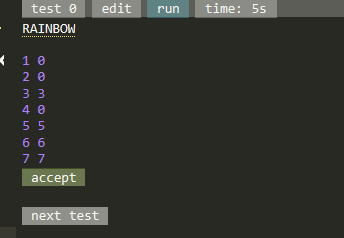Linear Recurrence : Introduction
Fibonacci Sequence is one of the simplest examples of a linear recurrence: $$$F_x = F_{x-1} + F_{x-2}$$$, with $$$F_0 = 0, F_1 = 1$$$
Here is a more general example of a linear recurrence:
\begin{align} R_{x} = \sum_{i=1}^{n}{C_i \cdot R_{x-i}} \end{align}
where $$$C_i$$$ is constant and $$$R_x$$$ is the x-th term of the recurrence. Since $$$R_x$$$ depends on the previous $$$n$$$ terms of the recurrence, it is called a linear recurrence of order $$$n$$$. It is called a "Linear" Recurrence, since we do not have any terms of the type $$$R_x \cdot R_y$$$
Note: We need $$$n$$$ initial conitions for a linear recurrence of order $$$n$$$, for example, we have 2 initial conditions for the Fibonacci Sequence.
Iternary
In this blog we will learn about various methods of solving the following problem: Given a Linear Recurrence of order $$$N$$$, find the $$$K$$$-th term of the recurrence. There are various methods to do this:
- $$$O(N \cdot K)$$$ using DP
- $$$O(N^3 \cdot logK)$$$ using Matrix Exponentiation
- $$$O(P(n) \cdot logK)$$$ using Characterstic Polynomials where $$$P(n)$$$ is the time required for polynomial multiplication — which can be $$$O(N^2)$$$ naively or $$$O(N^{1.58})$$$ using Karatsuba Multiplication or $$$O(N logN)$$$ using Fast Fourier Transform.
DP Solution
The $$$O(N \cdot K)$$$ solution is pretty trivial. (Assume dp[0] .. dp[n-1] are stored correctly as initial conditions)
for(int i = n; i < k; i++){
dp[i] = 0;
for(int j = 1; j <= n; j++){
dp[i] += c[j] * dp[i - j];
}
}
Matrix Exponentiation
You can find more detailed explanations on this technique here and here. But here I've described it briefly:
Let's look at the problem from another angle. From the DP solution, it is clear that we need to keep track of the previous $$$n$$$ elements at all times, and it won't matter even if we "forget" other elements. So let's keep a column vector of the "current" $$$n$$$ consecutive elements. Since the recurrence relation is a Linear Relation, it is possible to have a linear transformation to get the next elements.
\underrightarrow{\text{A Linear Transformation}}
\begin{bmatrix} R_{n} \\ R_{n-1} \\ \vdots \\ R_1\\ \end{bmatrix} $$$
Finding this linear transformation is quite intuitive and it can be expressed as multiplication with a square matrix, so let's directly write the general result.
\begin{bmatrix} R_{i+(n-1)} \\ R_{i+(n-2)} \\ R_{i+(n-3)} \\ \vdots \\ R_{i+(0)}\\ \end{bmatrix}
\implies
\begin{bmatrix} R_{i+(n)} \\ R_{i+(n-1)} \\ R_{i+(n-2)} \\ \vdots \\ R_{i+(1)}\\ \end{bmatrix} $$$
Reader is advised to take a moment to manually mutliply the matrices and verify the above result for a better understanding.
Alright, so a multiplication with the Transformation Matrix shifts the elements of the vector by $$$1$$$ index each, so we can shift it by $$$X$$$ indices by multiplying the transformation matrix to it $$$X$$$ times. However we take advantage of the fact that we can first multiply the transformation with itself $$$X$$$ times and then multiply it with the column vector. Why is this advantageous? Because we can use Binary Exponentiation! If we the transformation matrix is $$$T$$$, we can find $$$T^X$$$ in $$$O(N^3 logX)$$$ time. This lets us get the K-th term in $$$O(N^3 logK)$$$ time.
Check out this Mashup for practice problems
Using Characterstic Polynomial
I might've over-explained this section of the blog, because I personally found it very hard to understand this part when I initally learnt it.
I learnt about this technique from TLE's blog on Berlekamp Massey Algorithm, but since it wasn't explained in detail, I had a lot of difficulty in understanding this, so I'll try to explain it in a more beginner-friendly way. Apparently the name of this trick is Kitamasa Method.
First of all, an important observation
The original recurrence can be re-written as:
\begin{align} R_{j}-\sum_{i=1}^{n}{C_i \cdot R_{j-i}} = 0 \end{align}
Which means, any multiple of $$$\left(R_{j}-\sum_{i=1}^{n}{C_i \cdot R_{j-i}}\right)$$$ is $$$0$$$ and if it is added or subtracted anywhere, the answer doesn't change.
Let's bring in Polynomials
In simple words, in the linear recurrence, replace $$$R_{i}$$$ with $$$x^i$$$ everywhere to a get a polynomial equation. Multiplying $$$x$$$ to every element of the polynomial would just mean adding $$$1$$$ to all the subscripts in the linear recurrence. It is quite obvious to see that adding or subtracting such polynomial equations is also allowed. "Allowed? For what?" — For converting the polynomial back to the recurrence! Yes! This is a bit magical.
Try to check it on a few cases manually to verify that it is always allowed to do the following:
- Convert the linear recurrence into polynomial equation
- Add/Subtract/Multiply the polynomial equation with $$$x$$$ or some constants
- Convert the polynomial back to linear recurrence (replace $$$x^i$$$ with $$$R_{i}$$$ everywhere)
The final equation that you get after this, will be valid.
Alright, so what now? Let's convert the original recurrence into a polynomial (It is called the Characterstic Polynomial of the Reccurence)
\begin{align} f(x) = x^n-\sum_{i=1}^{n}{C_i \cdot x^{n-i}} \end{align}
Now since we know that upon converting the characterstic polynomial back to recurrence form, its value will be 0. We take advantage of this — Any multiple of the characterstic polynomial can be added or subtracted without any effect on the result.
We want to find $$$R_K$$$, upon converting it to polynomial we get $$$x^K$$$
We wish to find $$$\left(x^K + m(x) \cdot f(x)\right)$$$, where $$$m(x)$$$ is any polynomial! (Since $$$f(x)$$$ will be $$$0$$$ upon converting back to recurrence)
Now the idea is simple, we choose $$$m(x)$$$ in such a way that, only terms with degree less than $$$n$$$ remain. To do so, we pick, $$$m(x)$$$ as the negative of the quotient when $$$x^K$$$ is divided by $$$f(x)$$$. Which eventually leaves us with $$$x^K$$$ $$$mod$$$ $$$f(x)$$$
Hence the final solution
Find $$$x^K$$$ $$$mod$$$ $$$f(x)$$$ and then convert it to recurrence, which will have only terms $$$R_0, R_1, \cdots, R_{n-1}$$$
They way to do this is:
- Figure out how to calculate poly mod poly. (remainder when a polynomial is divided by another polynomial)
- Use binary exponentiation to find $$$x^K$$$ $$$mod$$$ $$$f(x)$$$
It is easy to see that there will be $$$O(logK)$$$ steps, with each step involving poly mod poly.
Hence using FFT, this can be done in $$$O(N logN logK)$$$
"Wait! You didn't tell how to do Poly mod Poly!"
Now, I won't be explaining how to do Poly mod Poly, because it is pretty easy to do naively in $$$O(N^2)$$$, and very complex using FFT in $$$O(N logN)$$$ — You can read about it here.
However, you can just use Poly mod Poly as a black box and use this code library by adamant (Although it is not very optimized, but it is good for basic use)
Practice Problems
You can also try the problems from the matrix exponentiation mashup using this technique, but it'll be an overkill.












